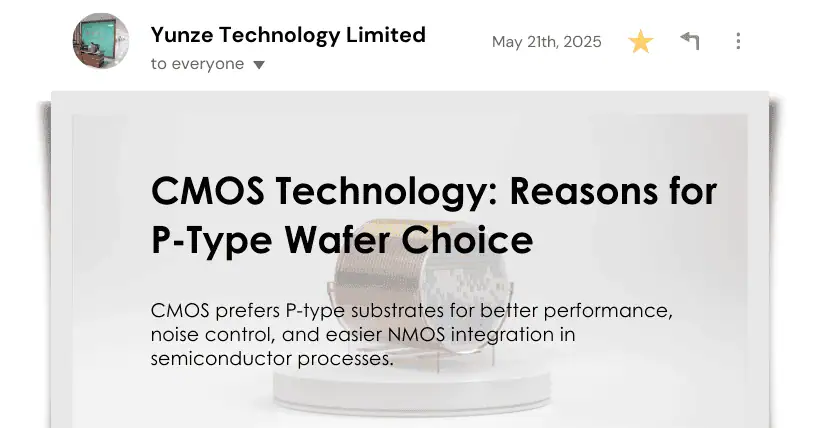In the field of integrated circuit manufacturing, CMOS (Complementary Metal-Oxide-Semiconductor) technology holds an overwhelmingly dominant position, and almost all mainstream CMOS chips use P-type silicon wafers as the substrate. This choice is not accidental but is the result of a comprehensive interplay of semiconductor physical properties, process optimization, electrical performance balancing, and industrial ecosystem evolution.
01
I. Technological Foundation: Starting from the Basic Properties of Semiconductors
The core of CMOS technology lies in constructing a complementary structure of N-type and P-type metal-oxide-semiconductor field-effect transistors (MOSFETs): NMOS transistors conduct via electrons, while PMOS transistors conduct via holes. A P-type wafer is silicon-based and formed by doping with trivalent elements such as boron (B), where holes are the majority carriers and electrons are the minority. On this substrate, NMOS source and drain regions are formed by doping with pentavalent elements like phosphorus (P) or arsenic (As) to create N-type regions, whereas for PMOS transistors, an N-well must first be built on the P-type substrate before forming P-type source and drain regions within the well, enabling coexistence of both transistor types.
02
II. Manufacturing Process: From Process Optimization to Cost Control
✅ Natural Advantage in Process Simplification
When fabricating NMOS on a P-type substrate, N-type source and drain regions can be formed directly through ion implantation or diffusion. The N-well required for PMOS can be realized using standard deep-well processes. Compared to N-type substrates, which require forming a P-well for NMOS, P-type substrates reduce process steps by about 10%–15%. Particularly in early semiconductor manufacturing, deep-well processes were more mature and compatible with equipment, significantly reducing development complexity.
✅ Process Compatibility with Material Properties
Boron (B), the P-type dopant, has unique diffusion characteristics: its small atomic radius and low diffusion coefficient in silicon make it easy to form precise shallow junctions, which is critical for submicron devices. In contrast, N-type dopant phosphorus (P) diffuses faster and is harder to control in terms of junction depth, especially when early photolithography techniques were limited in precision. This controllability gives P-type wafers greater stability during critical steps like lithography and ion implantation.
✅ Path Dependence in the Industrial Ecosystem
Modern CMOS processes have evolved since the 1960s, with early technical development centered around P-type substrates. As industry specialization advanced, equipment manufacturers (such as lithography and ion implantation equipment vendors) and materials suppliers (such as wafer manufacturers) optimized their production processes for P-type substrates, forming a mature supply chain. Statistics show that P-type wafers cost 15%–20% less to manufacture than equivalent N-type wafers, benefiting from economies of scale.
03
III. Electrical Performance: From Noise Control to Device Isolation
✅ The Art of Carrier Property Balancing
Although electron mobility (~1500 cm²/(V·s)) is about three times that of holes (~500 cm²/(V·s)), making N-type substrates theoretically better for high-speed devices, the core advantage of CMOS lies in its complementary structure’s low static power consumption. The majority carriers in P-type substrates are holes, whose lower mobility reduces subthreshold leakage currents—especially critical in deep-submicron processes, where leakage current increases exponentially with size reduction. Measurements show that NMOS leakage on P-type substrates is an order of magnitude lower than PMOS leakage on equivalent N-type substrates, which is crucial for battery-powered mobile chips.
✅ Natural Convenience of Substrate Biasing
In circuit design, P-type substrates are usually grounded (GND), keeping the NMOS substrate and source at the same potential, naturally forming a reverse-biased PN junction to avoid parasitic transistor effects. The N-well for PMOS connects to the power supply (VDD), also achieving reverse-bias isolation. This natural biasing requires no additional isolation devices, simplifying layout and improving electrical isolation between devices. In contrast, N-type substrates require complex well biasing networks, increasing design difficulty and chip area.
✅ Positive Use of Parasitic Devices
P-type substrates inherently contain native NMOS transistors, whose conductive channels form naturally between the substrate and source/drain regions without extra lithography steps. Although limited in performance, these devices play key roles in ESD protection and latch-up prevention circuits. For example, native NMOS-based ESD diodes provide overvoltage protection without added process steps, a significant advantage in cost-sensitive consumer electronics.
Those familiar with manufacturing WAT (Wafer Acceptance Test) know that each product’s electrical parameters include data on native NMOS and native IO NMOS devices. Compared to PMOS, these devices offer faster speeds and stronger drive capabilities.
04
IV. Reliability and Stability: From Thermal Processing to Long-Term Operation
During high-temperature processes (e.g., oxidation, diffusion, annealing), P-type substrates show better thermal stability. Boron-doped silicon lattices have lower atomic mobility at temperatures above 1000°C and more stable dopant distribution, which is crucial for CMOS processes requiring multiple high-temperature treatments. This is especially vital in modern FinFET and 3D integration processes, where complex multilayer structures demand strict control over substrate thermal expansion and crystal integrity. The mature process window of P-type wafers is a key advantage.
Additionally, P-type substrates have lower surface state density and fewer oxide layer defects, allowing for the formation of higher-quality gate oxide layers. This directly affects transistor threshold voltage stability and lifespan. Long-term reliability testing shows that gate leakage degradation in CMOS devices using P-type substrates is over 30% slower than in those with N-type substrates—crucial for automotive and industrial control chips requiring service lifetimes of over ten years.
05
Conclusion: A Systematic Victory of Technological Choices
CMOS technology’s preference for P-type wafers is essentially the optimal result of balancing technical feasibility, manufacturing cost, and performance within the semiconductor industry chain. From early process path dependence to deep compatibility between material properties and device structures, and finally to reliability advantages in modern nanoscale processes, every characteristic of P-type wafers fits seamlessly into the CMOS system. Although demand for N-type substrates is rising in specialized areas like power semiconductors and RF devices, P-type wafers will continue to dominate the logic chip market—over 80% of total share—illustrating not only the inevitable outcome of technological evolution but also the coordinated optimization of the entire semiconductor ecosystem.

Disclaimer:
- This channel does not make any representations or warranties regarding the availability, accuracy, timeliness, effectiveness, or completeness of any information posted. It hereby disclaims any liability or consequences arising from the use of the information.
- This channel is non-commercial and non-profit. The re-posted content does not signify endorsement of its views or responsibility for its authenticity. It does not intend to constitute any other guidance. This channel is not liable for any inaccuracies or errors in the re-posted or published information, directly or indirectly.
- Some data, materials, text, images, etc., used in this channel are sourced from the internet, and all reposts are duly credited to their sources. If you discover any work that infringes on your intellectual property rights or personal legal interests, please contact us, and we will promptly modify or remove it.








